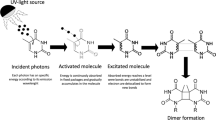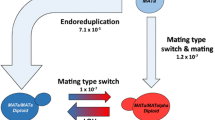Abstract
Experimental curves of the dependence of survival and delayed colony formation on UV light (254 nm) fluence for two wild-type strains of diploid yeast Saccharomyces cerevisiae capable of recovering from UV damage and their UV-sensitive mutants are presented. The dose–response curves were sigmoid for wild-type cells and rad6/rad6 and rad18/rad18 mutants, which were sensitive to UV irradiation by a factor of 2.2 and 1.5 for survival and 2.0 and 3.1 for delayed colony formation in comparison with the original strain (XS800). The T2 (rad2/rad2) strain was characterized by an exponential dose–response curve and was more sensitive to UV irradiation by a factor of 10.7 for survival and 7.0 for delayed colony formation compared to the original strain (T1). Delayed colony formation of all studied strains reached 100% with increasing UV light fluence. Unlike traditional representations, these data indicate that the delayed colony formation is mainly determined by cell ploidy and does not depend on the shape of the dose–response curves and UV sensitivity of cells.

Similar content being viewed by others
REFERENCES
Ultraviolet radiation, Geneva: WHO, 1995. https://www.who.int/uv/en/.
Shore, R.E., Overview of radiation-induced skin cancer in humans, Int. J. Radiat. Biol., 1990, vol. 57, no. 4, pp. 809—827.
Kielbassa, C., Roza, L., and Epe, B., Wavelength dependence of oxidative DNA damage induced by UV and visible light, Cancerogenesis, 1997, vol. 18, no. 4, pp. 811—816.
Tolstorukov, I.I., Bliznik, K.M., and Korogodin, V.I., Mitotic instability of diploid yeast cells of Pichia pinus: 1. Spontaneous cleavage, Genetica (Moscow), 1979, vol. 15, no. 12, pp. 2140—2147.
Chang, W.P. and Little, J.B., Persistently elevated frequency of spontaneous mutations in progeny of CHO clones surviving X-irradiation: association with delayed reproductive death phenotype, Mutat. Res., 1992, vol. 270, no. 2, pp. 191—199.
Marder, B.A. and Morgan, W.F., Delayed chromosomal instability induced by DNA damage, Mol. Cell. Biol., 1993, vol. 13, no. 11, pp. 6667—6677.
Vorobtsova, I.E., Transgenic transfer of radiation-induced genome instability and the susceptibility to carcinogenesis, Vopr. Onkol., 2008, vol. 54, no. 4, pp. 490—493.
Kapul’tsevich, Yu.G., Korogodin, V.I., and Petin, V.G., Analysis of radiobiological reactions of yeast cells: 1. Survival curves and the grow-up effect, Radiobiologiya, 1972, vol. 12, no. 2, pp. 267—271.
Korogodin, V.I., Bliznik, K.M., Kapultcevich, Yu.G., et al., Cascade mutagenesis: regularities and mechanisms, Proceedings of the 2nd International N.W. Timofeef-Ressovsky Conference, Dubna, 2007, vol. 1, pp. 419—447.
Evstratova, E.S., Pereklad, O.V., and Khryachkova, A.V., RBE of α-particles for delayed production of colonies by irradiated yeast cells, Radiats. Biol. Radioekol., 2016, vol. 56, no. 5, pp. 481—486.
Evstratova, E.S., Pereklad, O.V., and Petin, V.G., Dependence of radiation-induced genetic instability on the yeast cell ploidy, Radiat. Risk, 2016, vol. 25, no. 4, pp. 80—89.
Evstratova, E.S., Khryachkova, A.V., Zhurakovskaya, G.P., et al., UV-induced genetic instability of yeast cells, Radiats. Biol. Radioekol., 2018, vol. 58, no. 3, pp. 245—250.
Petin, V.G., Pereklad, O.V., Nili, M., et al., Yeast cells retain a memory of their original radiation-induced insult, J. Radiat. Ind., 2008, vol. 2, no. 2, pp. 59—64.
Petin, V.G., Zhurakovskaya, G.P., and Komarova, L.N., Radiobiologicheskie osnovy sinergicheskogo vzaimodeistviya v biosfere (Radiobiological basis of Synergistic Interaction in the Biosphere), Moscow: GEOS, 2012.
Melloni, E., Marchesini, R., Emanuelli, H., Fava, G., et al., Hyperthermal effects in phototherapy with hematoporphyrin derivative sensitization, Tumori, 1984, vol. 70, no. 4, pp. 321—325.
Waldow, S.M. and Dougherty, T.J., Interaction of hyperthermia and photoradiation therapy, Radiat. Res., 1984, vol. 97, no. 2, pp. 380—385.
Evstratova, E.S. and Petin, V.G., The delayed appearance of haploid and homozygous diploid Saccharomyces cerevisiae yeast cells of wild-type and radiosensitive mutants surviving after exposure to gamma rays and alpha particles, J. Radiat. Res. Appl. Sci., 2018, vol. 11, no. 1, pp. 98—103.
Korogodin, V.I., Bliznik, K.M., Kapul’tsevich, Yu.G., and Petin, V.G., Assessment of mitotic recombination frequency in clones growing from irradiated cells, Radiobiologiya, 1974, vol. 14, no. 5, pp. 681—685.
Chang, W.P. and Little, J.B., Evidence that DNA double-strand break initiate the phenotype of delayed reproductive death in Chinese hamster ovary cells, Radiat. Res., 1992, vol. 131, no. 1, pp. 53—59.
Urushibara, A., Kodama, S., and Yokoya, A., Induction of genetic instability by transfer of a UV-A-irradiated chromosome, Mutat. Res., 2014, vol. 766, no. 1, pp. 29—34.
Sheltzer, J.M., Blank, H.M., Pfau, S.J., et al., Aneuploidy drives genomic instability in yeast, Science, 2011, vol. 333, no. 6045, pp. 1026—1030.
Kaprin, A.D., Galkin, V.N., Zhavoronkov, L.P., et al., Synthesis of basic and applied research: the basis for ensuring a high level of scientific results and their implementation in medical practice, Radiat. Risk, 2017, vol. 26, no. 2, pp. 26—40.
Funding
This work was carried out in the framework of implementing the state task of the Tsyb Medical Radiological Research Center, the branch of the National Medical Research Radiological Center of the Ministry of Health of Russia, for 2015–2017, the intermediate results of which were reflected in the generalizing publication [22]. This work was partly supported by the grant of the President MK-872.2018.4 (contract no. 075-02-2018-570).
Author information
Authors and Affiliations
Corresponding author
Ethics declarations
The authors declare that they have no conflict of interest. This article does not contain any research using animals as objects. This article does not contain any research involving human subjects as objects of research.
Additional information
Translated by K. Lazarev
Rights and permissions
About this article
Cite this article
Evstratova, E.S., Korolev, V.G. & Petin, V.G. Delayed Colony Formation in Diploid Cells of Various Genotypes after UV Light Irradiation. Russ J Genet 55, 904–907 (2019). https://doi.org/10.1134/S1022795419070068
Received:
Revised:
Accepted:
Published:
Issue Date:
DOI: https://doi.org/10.1134/S1022795419070068




